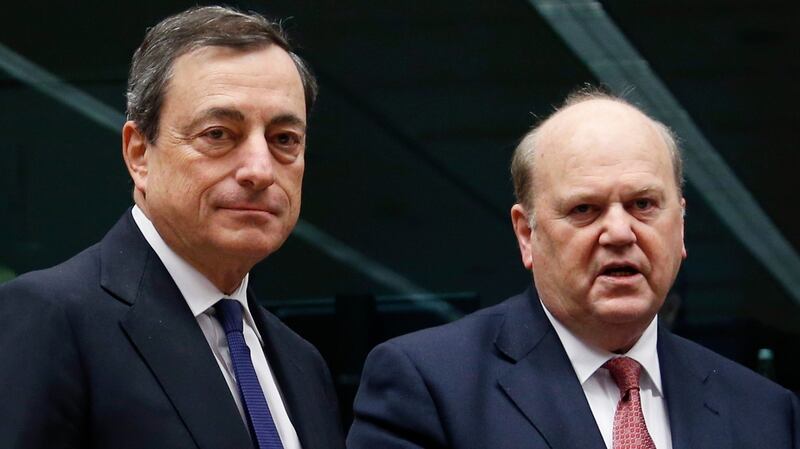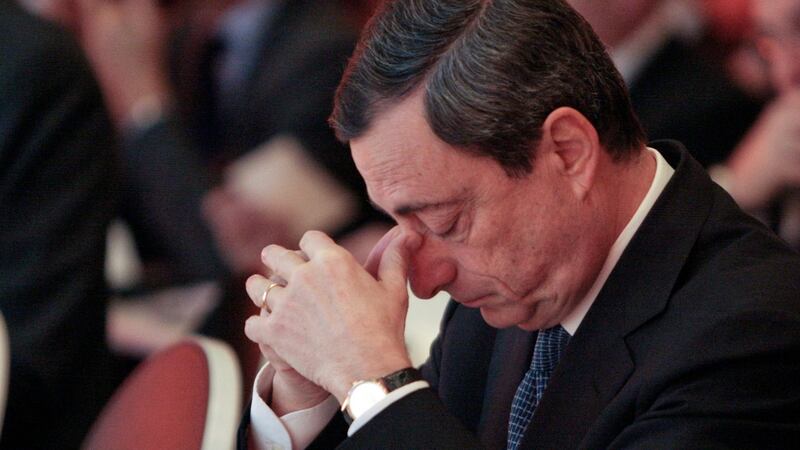Mario Draghi leaves the European Central Bank this week as a different institution to the one he took charge of eight years ago.
Thursday’s ECB meeting will be Mr Draghi’s last. He is widely known for having shored up faltering support for the euro. But his legacy also extends to the central bank’s balance sheet, which is much larger, the bond markets, where yields are near record lows, and inflation, which is still well below target.
Frederik Ducrozet, a strategist at Pictet Wealth Management, said Mr Draghi had transformed the institution “into a modern central bank” by “using a broad, innovative, efficient and flexible toolkit of unconventional policy measures”.
Here are the five key data points that sum up Mr Draghi’s ECB legacy.
Expanding the toolbox
Two months after he arrived in Frankfurt Mr Draghi reversed his predecessor Jean-Claude Trichet’s two interest rate rises – but that was not enough to prop up the euro zone economy.
Rate changes were not being transmitted to the private sector via bank lending rates, he argued; new instruments were needed.
He expanded the ECB’s policy toolbox to include generous subsidised lending to banks to help shore up their balance sheets, negative rates to lower borrowing costs and sovereign bond purchases to bring down the market interest rates faced by the bloc’s most troubled economies.
Lucrezia Reichlin, economics professor at the London Business School and the ECB’s former head of research under Mr Draghi, said: “We were in recession and financial markets were dysfunctional, so he changed that by bringing all the pieces of monetary policy behind the effort to fix them.”
The ECB has subsequently accumulated €2.6 trillion of assets, including nearly a quarter of member states’ outstanding bonds.
Critics in northern Europe complained that these programmes were beyond the bank’s mandate, while others warned that the negative side-effects outweighed the benefits.

Reducing bond market risk
In the euro zone, government bond yields measure investors’ perception of risk – the more likely the markets think it is that a country will crash out of the bloc, the wider the spread between its yields and those of Germany, the single currency’s largest economy.
During Mr Draghi’s tenure peripheral countries’ spreads shot up to historic highs as investors became fearful that they would be unable to finance their rising debt levels or stimulate their struggling economies.
The bloc’s banks are large holders of their home nations’ debt, so the sovereign debt crisis soon evolved into a banking crisis, and that in turn hit lending to households and businesses.
The subsequent retrenchment in euro zone bond spreads demonstrated that Mr Draghi’s use of unconventional monetary policy had worked, economists say.
“It is widely agreed that [his] pledge to make the ECB the de facto lender of last resort to governments was the key to arresting the euro crisis,” said Christian Odendahl, chief economist at the Centre for European Reform.
Addressing unemployment
The unprecedented monetary stimulus over which Mr Draghi presided has had a tangible real-world consequence: an improvement in the labour market.
The unemployment rate soared after the financial crisis, topping 12 per cent across the bloc in 2013.
But as lending to non-financial businesses and households began to expand again in 2015, economic growth returned – in 2017 all 19 member states saw their economies grow for the first time since the crisis.
As a result, the number of people in employment has risen by 11 million since 2013, and the unemployment rate has dropped to its lowest level in more than a decade.
That has begun to feed through into people’s pockets – wage growth has recently started to pick up.

Safeguarding the single currency
Since its creation in 1999, a stubborn minority of people across the euro zone have opposed the existence of the single currency.
But during Mr Draghi’s time in office, the size of that group has shrunk notably.
When discontent was at its peak, nearly 40 per cent of the population in peripheral countries such as Greece, Portugal, Spain and Italy turned against the euro, as they struggled with rising unemployment rates and soaring budget deficits.
The turning point came when Mr Draghi’s use of unconventional monetary policy reassured investors of the solidity of the currency union, and Greece avoided crashing out of the bloc in 2015.
Trust in both the ECB and the common currency has since risen and today the euro is more popular that it has ever been in its 20 years of existence.
Failing on inflation
The ECB’s primary mandate is to maintain price stability, which it defines as a year-on-year inflation rate of below but close to 2 per cent.
The rate of price growth has remained below this level for most of Mr Draghi’s tenure – the euro zone consumer price index is 7 per cent below the level it would have been if the ECB had met its inflation target since 2011.
So, despite his other achievements, he did not deliver on his main objective.
“Mario Draghi’s greatest paradox is that he has been one of the most active and credible central bankers in modern history, yet he will leave the ECB with one of the worst track records in terms of inflation targeting,” said Mr Ducrozet.
There is little prospect of inflation picking up anytime soon - in September CPI dropped to 0.8 per cent, a three-year low, and the ECB forecasts that it will remain muted for the foreseeable future.
“There is no other way to put it: under Draghi, the ECB has failed to fulfil its mandate,” said Mr Odendahl. – Copyright The Financial Times Limited 2019











